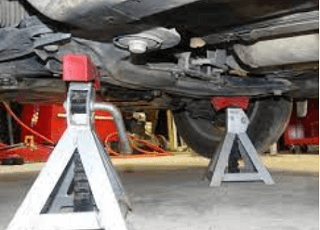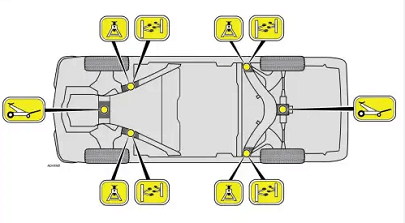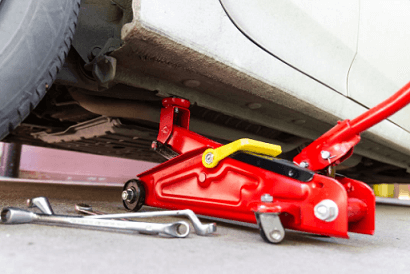To jack up a car and change the oil, park the car on a flat surface, locate the jack points under the car, position the jack accordingly, pump the jack handle until the car is lifted, and secure it with jack stands before beginning the oil change. Jackin’ up a car to change its oil is a fairly straightforward process that can save you time and money.
By following a few simple steps, you’ll have your car up in no time, ready for some DIY maintenance. In this guide, we’ll walk you through the process step by step, ensuring you know exactly what to do to safely lift your vehicle and get started on that oil change.
Whether you’re a car enthusiast or a novice DIYer, this guide will equip you with the knowledge to successfully jack up your car and complete an oil change with ease. So, let’s dive right in!
Why Jacking Up Your Car Is Important For An Oil Change
The process of jacking up a car is crucial when it comes to changing the oil. Proper car elevation plays a significant role in ensuring the success of this task, as well as maintaining the safety of both the vehicle and the person working underneath it.
Before lifting the vehicle, it is important to follow some safety precautions. Firstly, ensure that you are parked on a level surface to prevent the car from rolling. Secondly, engage the parking brake to provide an additional layer of security. Lastly, place wheel chocks in front of and behind the tires to prevent any inadvertent movement.
By adhering to these safety measures, you minimize the risk of accidents and injuries that could potentially occur during the oil change process. Remember, safety should always be a top priority when working on any vehicle.
Choosing The Right Jack For Your Car
Choosing the right jack for your car is crucial to ensure a safe and successful oil change. There are different types of jacks available, and it’s important to select the one that is compatible with your vehicle’s weight and design.
One factor to consider is the type of jack suitable for your car. There are hydraulic jacks, scissor jacks, and floor jacks, each with its own advantages and disadvantages. Hydraulic jacks are commonly used for larger vehicles, while scissor jacks are typically found in small and compact cars. Floor jacks, on the other hand, are versatile and suitable for most vehicles.
Another important consideration is the jack’s compatibility with your vehicle. Every jack has a weight limit, and it’s crucial to choose one that can safely support your car’s weight. Additionally, some jacks may be designed specifically for certain vehicle models or have specific lifting points, so it’s essential to check the manufacturer’s guidelines to ensure compatibility.
| Type of Jack | Suitable for |
|---|---|
| Hydraulic Jack | Larger vehicles |
| Scissor Jack | Small and compact cars |
| Floor Jack | Most vehicles |
Choosing the right jack for your car is essential to ensure a safe and successful oil change. Consider the type of jack suitable for your car, its compatibility with your vehicle’s weight and design, and follow the manufacturer’s guidelines for proper usage.

Step-by-step Guide On How To Jack Up Your Car
Preparations before lifting the car: Before attempting to jack up your car to change the oil, it is crucial to gather the necessary tools and ensure your safety. Make sure the car is parked on a level surface, the engine is turned off, and the parking brake is engaged. Wear protective gloves and eye goggles to avoid any potential injuries.
Locating the proper jacking points on the vehicle: Each vehicle has specific jacking points recommended by the manufacturer. These points are usually indicated in your car’s manual. It is important to locate these points before proceeding with the lifting process.
Placing the jack securely and ensuring stability: Position the hydraulic jack under the designated jacking point, ensuring it is centered and aligned properly. Double-check the stability of the jack before starting to lift the car.
Raising the car gradually and safely: Slowly pump the hydraulic jack to raise the vehicle off the ground. Keep an eye on the car’s stability and make sure it remains balanced as you proceed.
Proper placement of jack stands for added security: Once the car is lifted to the desired height, place jack stands under the vehicle at recommended points. This additional measure provides extra security while working underneath the car.
Additional Tips For A Safe And Efficient Jacking Process
When jacking up a car to change oil, it is crucial to ensure a stable and secure environment. Proper preparation can prevent accidents and injuries. Firstly, make sure you have an even and firm surface to jack the car up on. A flat and solid ground provides the necessary stability during the process.
Moreover, never rely solely on the jack to support the car. Always use additional safety measures to ensure your safety. Use wheel chocks to prevent any unwanted rolling of the vehicle. minimize the risk of the car slippingthe risk of the car slipping or gaining momentum.
Remember, it is essential to prioritize your safety when working underneath a car. Following these additional precautions will help you have a smooth and accident-free jacking process.
Safety Measures When Working Under A Jacked Up Car
When jacking up your car to change oil, it is crucial to prioritize safety measures for your well-being. Utilizing jack stands for support is essential to prevent accidents and ensure stability. These sturdy stands should be placed on level ground and positioned correctly under the vehicle’s designated lifting points.
Equally important is wearing the appropriate safety gear and equipment. This includes safety glasses to protect your eyes from debris, gloves to shield your hands, and a high-visibility vest to enhance visibility to others.
Avoiding unnecessary weight shifts while working under a jacked-up car is vital. Refrain from leaning or exerting excessive force on the vehicle, as it can lead to instability. Any sudden movements or attempts to lift the car even higher can increase the risk of accidents and injury.
Always prioritize safety when performing maintenance tasks on your vehicle. By following these precautions, you can ensure a safer environment while changing your car’s oil.
Lowering Your Car And Removing The Jack
To safely lower your car and remove the jack, follow these step-by-step instructions:
- Ensure the car is parked on a flat, level surface and the engine is turned off.
- Locate the jack points under the car, usually indicated by notches or arrows. Place the jack stand under the appropriate jack point.
- Slowly lower the car by turning the release valve on the jack counterclockwise. Pay close attention to any movement or instability.
- Once the car is securely resting on the jack stand, double-check for stability by gently pushing the car from different angles.
- If the car is stable, carefully remove the jack by reversing the process used for jacking the car up.
- Make sure to never place any body part under the car while removing the jack.
- Inspect the jack for any damage or issues before storing it away.
- Finally, check that the car is level and secure on the jack stand before attempting any maintenance or repairs.

A Quick Recap: Jacking Up Your Car For A Quick Oil Change
Recap of the key steps and safety precautions:
- Step 1: Find a flat, stable surface: When changing your car’s oil, it is crucial to park on a level ground to ensure stability and prevent accidents. Avoid slopes or uneven surfaces.
- Step 2: Locate the jack points: Consult your vehicle’s manual to identify the proper jack points. These are specific areas on the car’s frame where the jack should be positioned for safe and effective lifting.
- Step 3: Secure the vehicle: Use wheel chocks to prevent the car from rolling while you elevate it. These small wedges should be placed on the opposite side of the car from the one you are lifting.
- Step 4: Lift the car: Slowly pump the hydraulic jack to raise the car until it reaches the desired height. Double-check that the jack is positioned correctly and the car is stable before proceeding.
- Step 5: Place jack stands: Once the car is raised, position jack stands under the designated points for added security. These stands will hold the weight of the car while you work underneath.
- Step 6: Lower the car: Using the hydraulic jack, lower the car gradually onto the jack stands. Ensure the car is resting securely on the stands before releasing the jack.
- Step 7: Begin the oil change: With the car safely elevated on jack stands, you can proceed with the oil change process, following the specific instructions provided by the manufacturer.
Properly elevating your car using a jack and jack stands is crucial to ensure your safety and to facilitate a smooth oil change. By following these steps and taking necessary precautions, you can confidently perform this maintenance task without any risk to yourself or your vehicle.
Frequently Asked Questions For How To Jack Up A Car To Change Oil
How Do I Safely Jack Up My Car To Change The Oil?
To safely jack up your car to change the oil, start by parking on a level surface. Find the manufacturer’s recommended jacking points and place a jack stand on each side of the car for stability. Carefully lift the car using a hydraulic jack, making sure it is secure before crawling underneath to change the oil.
Can I Use A Regular Car Jack To Change The Oil?
While a regular car jack can lift your car, it is not recommended for changing the oil. Hydraulic floor jacks or trolley jacks are more stable options. They provide better support and stability, reducing the risk of accidents while working underneath your vehicle.
How Often Should I Change My Car’s Oil?
The general rule is to change your car’s oil every 5,000 to 7,500 miles or every six months, whichever comes first. However, it is essential to check your car’s manual for the manufacturer’s recommended oil change intervals as they can vary depending on the vehicle make and model.
Do I Need To Jack Up The Car To Change The Oil Filter?
In most cases, you do not need to jack up your car to change the oil filter. The oil filter is accessible from under the hood or underneath the vehicle, without the need for lifting the car. However, if your oil filter is located underneath the car, you may need to raise the vehicle for easier access.
Conclusion
Changing the oil in a car is an essential maintenance task that every car owner should learn. By following these steps to jack up your car and access the oil filter and drain plug, you can save money and ensure the longevity of your vehicle.
Remember to always prioritize safety and use proper equipment. With this guide, changing the oil in your car will be a breeze. Keep your engine running smoothly and extend the life of your car by performing this routine maintenance on a regular basis.


Leave a Reply